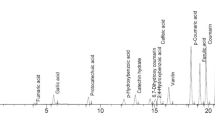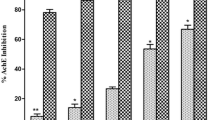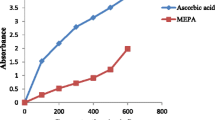Abstract
Tricholoma species, known as odorous mushrooms, are consumed in Anatolia as well as in the world. The antioxidant activity of extracts of Tricholoma fracticum, Tricholoma imbricatum and Tricholoma terreum was determined using five complementary tests: β-carotene/linoleic acid, DPPH⋅ scavenging, ABTS⋅+ scavenging, ferrous ion chelating assay and cupric-reducing antioxidant capacity assay. In the β-carotene/linoleic acid assay, the hexane extract of T. imbricatum showed 93.8 ± 1.4% lipid peroxidation inhibition at 0.8 mg/mL concentration, whilst in the ABTS⋅+ assay, the ethyl acetate extract of T. fracticum exhibited 88.8 ± 0.1% inhibition in the same concentration. In addition, the total phenolic and total flavonoid contents of Tricholoma species were determined as pyrocatechol and quercetin equivalents, respectively. The in vitro anticholinesterase activities of extracts of Tricholoma species were tested against acetylcholinesterase and butyrylcholinesterase, which are the key enzymes taking place in the pathogenesis of Alzheimer’s disease. The hexane extract of T. imbricatum demonstrated the best inhibition activity against acetylcholinesterase and butyrylcholinesterase enzymes, indicating 71.8 ± 0.3% and 52.6 ± 1.0% at 0.2 mg/mL concentration, respectively. These results showed that the tested extracts obtained from Tricholoma species, particularly T. imbricatum, can be considered as sources of food additives, as well as moderate anticholinesterase agents.
Similar content being viewed by others
References
Apak R, Güçlü K, Özyürek M, Karademir SE (2004) Novel total antioxidant capacity index for dietary polyphenols and vitamins C and E, using their cupric ion reducing capability in the presence of neocuproine: CUPRAC method. J Agr Food Chem 52:7970–7981
Blois MS (1958) Antioxidant determinations by the use of a stable free radical. Nature 181:1199–1200
Cook NC, Samman S (1996) Flavonoids—chemistry, metabolism, cardioprotective effects and dietary sources. J Nutr Biochem 7:66–76
Cheung LM, Cheung PCK, Ooi VEC (2003) Antioxidant activity and total phenolics of edible mushroom extracts. Food Chem 81:249–255
Cho IH, Namgung HJ, Choi HK, Kim YS (2008) Volatiles and key odorants in the pileus and stipe of pine-mushroom. Food Chem 106:71–76
Dabbour IR, Takruri HR (2002) Protein quality of four types of edible mushrooms found in Jordan. Plant Food Hum Nutr 57:1–11
Decker EA, Welch B (1990) Role of ferritin as a lipid oxidation catalyst in muscle food. J Agr Food Chem 38:674–677
Ding X, Tang J, Cao M, Guo C, Zhang X, Zhong J, Zhang J, Sun Q, Feng S, Yang Z, Zhao J (2010) Structure elucidation and antioxidant activity of a novel polysaccharide isolated from Tricholoma matsutake. Int J Biol Macromol 47:271–275
Duh PD, Tu YY, Yen GC (1999) Antioxidant activity of water extract of harn jyur (Chyrsanthemum morifolium Ramat). LWT Food Sci Technol 32:269–277
Dülger B, Yilmaz F, Gücin F (1999) Antimicrobial activity of Tricholoma terreum (Fr.) Kummer. Ecology 8:13–17
Ellman GL, Courtney KD, Andres V, Featherston RM (1961) A new and rapid colorimetric determination of acetylcholinesterase activity. Biochem Pharmacol 7:88–95
Ertunga NS, Cakmak U, Colak A, Faiz O, Sesli E (2009) Characterisation of esterolytic activity from two wild mushroom species, Amanita vaginata var. vaginata and Tricholoma terreum. Food Chem 115:1486–1490
Garlaschelli L, Pang ZJ, Sterner O, Vidari G (1994) New indole derivatives from the fruit bodies of Tricholoma sciodes and T. virgatum. Tetrahedron 50:3571
Grice HP (1988) Enhanced tumour development by butylated hydroxyanisole (BHA) from the prospective of effect on forestomach and oesophageal squamous epithelium. Food Chem Toxicol 26:717–723
Halliwell B, Gutteridge JMC (1984) Oxygen toxicity, oxygen radicals, transition metals and disease. Biochem J 219:1–4
Hatakeyama T, Mizuno K, Kurosawa S (2010) Purification and properties of a nuclease from the fruit body of Tricholoma matsutake. Biosci Biotechnol Biochem 74:206–208
Jayakumar T, Thomas PA, Geraldine P (2009) In-vitro antioxidant activities of an ethanolic extract of the oyster mushroom, Pleurotus ostreatus. Innovat Food Sci Emerg Tech 10:228–234
Kandaswami C, Middleton E (1997) Flavonoids as antioxidants. In: Shahidi F (ed) Natural antioxidants. Chemistry, health effects and practical applications. AOCS, Champaign, IL, pp 174–194
Kasuga A, Aoyagi Y, Sugahara T (1995) Antioxidant activity of fungus Suillus bovines (L:Fr.) O. Kuntze. J Food Sci 60:1113–115
Kım MY, Seguın P, Ahn JK, Kım JJ, Chun SC, Kım EH, Seo SH, Kang EY, Kım SL, Park YJ, Ro HM, Chung IM (2008) Phenolic compound concentration and antioxidant activities of edible and medicinal mushrooms from Korea. J Agr Food Chem 56:7265–7270
Knops L, Nieger M, Steffan B, Steglich W (1994) Novel diterpenoids from the toadstools Tricholoma aurantium and T. fracticum (Agaricales). Liebigs Ann 1995:77–80
Longvah T, Deosthale YG (1998) Compositional and nutritional studies on edible wild mushroom from northeast India. Food Chem 63:331–334
Marco GJ (1968) A rapid method for evaluation of antioxidants. J Am Oil Chem Soc 45:594–598
Mau JL, Lin HC, Song LF (2002) Antioxidant properties of several specialty mushrooms. Food Res Int 35:519–526
Moradali MF, Mostafavi H, Ghods S, Hedjaroude GA (2007) Immunomodulating and anticancer agents in the realm of macromycetes fungi (macrofungi). Int Immunopharmacol 7:701–724
Nishida Y, Yokota T, Takahashi T, Uchihara T, Jishage KI, Mizusawa H (2006) Deletion of vitamin E enhances phenotype of Alzheimer disease model mouse. Biochem Biophys Res Commun 350:530–536
Park YK, Koo MH, Ikegaki M, Contado JL (1997) Comparison of the flavonoid aglycone contents of Apis mellifera propolis from various regions of Brazil. Braz Arch Biol Techn 40:97–106
Re R, Pellegrini N, Proteggente A, Pannala A, Yang M, Rice-Evans C (1999) Antioxidant activity applying an improved ABTS radical cation decolorization assay. Free Radic Biol Med 26:1231–1237
Rout S, Banerjee R (2007) Free radical scavenging, antiglycation and tyrosinase inhibition properties of a polysaccharide fraction isolated from the rind from Punica granatum. Bioresource Technol 98:3159–3163
Sahu SC, Green S (1997) Food antioxidants: their dual role in carcinogenesis. In: Baskin S, Salem H (eds) Oxidants, antioxidants and free radicals. Taylor & Francis, Washington, pp 329–330
Sakai S, Tomomura Y, Yoshida H, Inoue S, Kawagishi H (2005) Orirubenones D to G, novel phenones from the Tricholoma orirubens mushroom. Biosci Biotechnol Biochem 69:1630–1632
Sastre J, Pallardo FV, Vina J (2000) Mitochondrial oxidative stress plays a key role in aging and apoptosis. IUBMB Life 49:427–435
Slinkard K, Singleton VL (1977) Total phenol analyses: automation and comparison with manual methods. Am J Enol Viticult 28:49–55
Soholm B (1998) Clinical improvement of memory and other cognitive functions by Ginkgo biloba: review of relevant literature. Adv Ther 15:54–65
Ohnuma N, Amemiya K, Kakuda R, Yaoita Y, Machida K, Kikuchi M (2000) Sterol constituents from two edible mushrooms, Lentinula edodes and Tricholoma matsutake. Chem Pharm Bull 48:749–751
Orhan I, Üstün O (2011) Determination of total phenol content, antioxidant activity and Acetylcholinesterase inhibition in selected mushrooms from Turkey. J Food Compos Anal 24:386–390
Tanaka M, Kuei CW, Nagashima Y, Taguchi T (1998) Application of antioxidative maillrad reaction products from histidine and glucose to sardine products. Nippon Suisan Gakk 54:1409–1414
Tong H, Xia N, Feng K, Sun G, Gao X, Sun L, Jiang R, Tian D, Sun X (2009) Structural characterization and in vitro antitumor activity of a novel polysaccharide isolated from the fruiting bodies of Pleurotus ostreatus. Bioresource Technol 100:1682–1686
Tsukamoto S, Macabalang AD, Nakatani K, Obara Y, Nakahata N, Ohta T (2003) Tricholomalides A–C, new neurotrophic diterpenes from the mushroom Tricholoma sp. J Nat Prod 66:1578–1581
Türkoğlu A, Duru ME, Mercan N, Kıvrak İ, Gezer K (2007) Antioxidant and antimicrobial activity of Laetiporus sulphureus (Bull.) Murrill. Food Chem 101:267–273
Williams GM, Iatropoulos M (1997) Anticarcinogenic effects of synthetic phenolic antioxidants. In: Baskin SI, Salem H (eds) Oxidants, antioxidants, and free radicals. Taylor & Francis, New York, pp 341–350
Velioglu YS, Mazza G, Gao L, Oomah BD (1998) Antioxidant activity and total phenolics in selected fruits, vegetables, and grain products. J Agr Food Chem 46:4113–4117
Yamac M, Bilgili F (2006) Antimicrobial activities of fruit bodies and/or mycelial cultures of some mushroom isolates. Pharm Biol 44:660–667
Yoshikawa K, Kuroboshi M, Ahagon S, Arihara S (2004) Three novel crustulinol esters, Saponaceols A–C, from Tricholoma saponaceum. Chem Pharm Bull 52:886–888
Zhang AL, Li YL, Ma YT, Gao JM, Jia AQ (2009) Phenolic meroterpenoids and steroids from the basidiomycete Tricholoma imbricatum. Biochemical Systematics and Ecology 37:756–758
Acknowledgements
The authors thank Professor Aziz TURKOĞLU, Nevşehir University, Faculty of Arts and Sciences, Department of Biology, for the identification of the mushroom species. The Sıtkı Koçman Foundation (SKV) is also acknowledged by the authors.
Author information
Authors and Affiliations
Corresponding author
Rights and permissions
About this article
Cite this article
Tel, G., Apaydın, M., Duru, M.E. et al. Antioxidant and Cholinesterase Inhibition Activities of Three Tricholoma Species with Total Phenolic and Flavonoid Contents: The Edible Mushrooms from Anatolia. Food Anal. Methods 5, 495–504 (2012). https://doi.org/10.1007/s12161-011-9275-4
Received:
Accepted:
Published:
Issue Date:
DOI: https://doi.org/10.1007/s12161-011-9275-4




